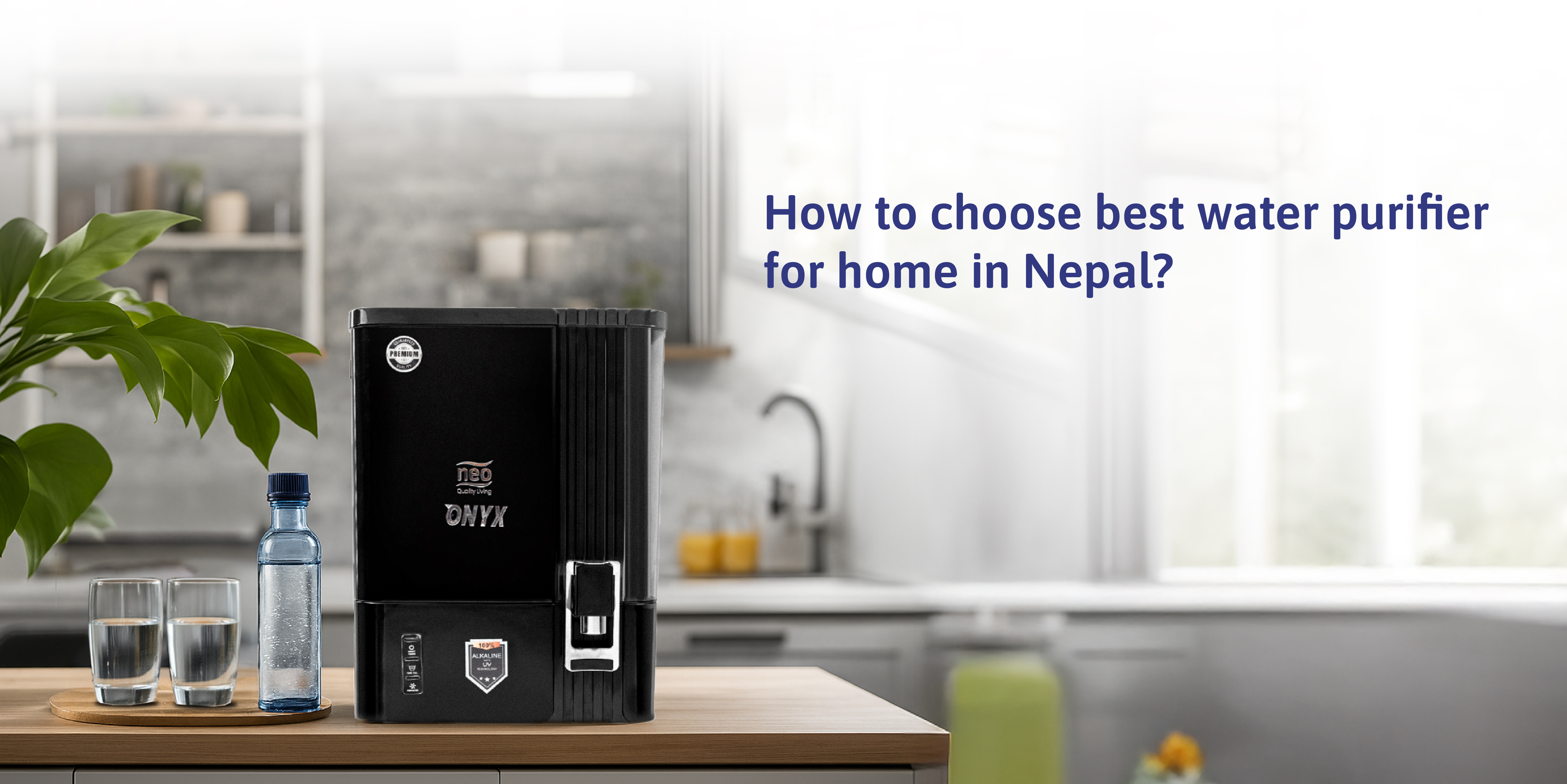
How to choose best water purifier for your home in Nepal?
You may have heard the saying, "Health is wealth." But hold on for a moment. Do you truly care about your health and the health of those you love? A healthy family and a healthy life are the true definitions of luxury. This is the fact that between 70 and 75 percent of the human body is made up of water. This illustrates importance of water to our daily existence. Understanding the quality of the water you drink and use to cook is so crucial. They can cause illnesses, including waterborne diseases. UN and World Vision estimate that waterborne illnesses take the lives of almost 3.5 million people worldwide each year. For this reason, you must ensure that the water you use for cooking and drinking is free of harmful contaminants that might make you sick or cause waterborne illnesses.
The market is filled with several kinds of water purifiers that can help defend you and your family against cholera, dysentery, typhoid, and hepatitis A, among other waterborne illnesses. You should read this blog if you are unsure about buying the best water purifier for your home. After reading this blog post, you will be ready to move forward with purchasing the best water purifier for your residence.
Things to Consider Before buying best water purifier for your home
There are some important things to keep in mind before making the decision to buy a water purifier for your home. You must know where your water comes from, what technologies water purifiers use, how much water you need each day, and be familiar with the brands and certifications of water purifiers, as well as their warranties and after-sales services.
Source of Water:
Identifying your water source is the first step in selecting the right purifier for your home. In Nepal, common sources include rivers, groundwater, springs, and rainwater. Understanding the source helps determine the type of treatment needed and whether water testing is necessary.
Water Testing:
In Nepal, a TDS (Total Dissolved Solids) meter is suitable for measuring the purity of various water sources, particularly for checking tap water or the effectiveness of water filters. For a more comprehensive assessment, including biological and chemical contaminants, laboratory testing is necessary.
If you're uncertain about whether to choose an RO (reverse osmosis) water purifier or one with UV+UF (ultraviolet and ultrafiltration) technology, it's important to first test the TDS (total dissolved solids) level of your water source.
- For TDS levels up to 150 ppm, a UV+UF water purifier is generally sufficient. These water purifier is ideal for low-TDS water typically found in municipal supplies.
- For TDS levels between 150 and 500 ppm, an RO water purifier is recommended.
- For TDS levels above 500 ppm, it is advisable to install a water softening or pre-treatment system before using an RO purifier.
Testing your water’s TDS level is one of the essential steps in selecting the most suitable purification technology, ensuring both safety and cost-efficiency in the long run.
Types of Water Purifier in Home
Reverse Osmosis (RO):
Water is purified using RO technology to make it safer and healthier to consume. It filters out a range of impurities by forcing water through a semi-permeable membrane. This technique separates water molecules from larger particles, ions, and unwanted chemicals, purifying water on one side while concentrating pollutants on the other. Additionally, it is used to eliminate germs, viruses, and other impurities. RO eliminates as many impurities as possible from water, up to 0.001 microns.
Ultra Violet (UV):
"UV," or ultraviolet light, is a disinfection technique that uses UV rays to destroy inactive microorganisms such as viruses, bacteria, and protozoa. These microorganisms' DNA is damaged by UV light, which stops them from replicating and makes them innocuous.
Ultra Filtration (UF):
In water treatment, ultrafiltration (UF) uses a semi-permeable membrane to physically separate impurities according to size. When water is forced through the membrane, particles bigger than the membrane's pores stay in place while water and smaller molecules are permitted to flow through. By successfully eliminating bacteria, viruses, suspended particulates, and other microbes, this technique provides remarkably pure water. Contaminants as small as 0.01 microns are eliminated.
Activated Carbon Filter:
In order to purify water, impurities are adsorbed onto the surface of activated carbon filters. Their high effectiveness in removing pesticides, organic compounds, and chlorine results in noticeable improvements in both taste and odor. However, not all contaminants are removed by these filters, including microorganisms, heavy metals, nitrates, and certain inorganic substances.
Alkaline Cartridge/filter:
This technique removes contaminants and adds healthy minerals to the water. It helps keep pH levels balanced, as the name suggests, so that the water doesn't get too acidic or alkaline. The water stream is added back with vital minerals that are frequently lost during filtering. These usually consist of calcium, magnesium, and potassium, and they all add to the treated water's overall health advantages.
Sediment Filters:
As a pre-filtration step, sediment filters efficiently remove bigger particles from the water, including sand, rust, and dirt. Sediment filters contribute to the preservation and longevity of subsequent, more fragile filtration components by absorbing these coarse contaminants. Furthermore, they enhance the general clarity of the water and lessen the possibility of clogging downstream filters and appliances.
Budget and Costing:
It is important to estimate the budget you are willing to allocate for purchasing a water purifier for your home. Several cost factors should be taken into account, including the initial purchase price, installation fees, maintenance expenses, and replacement parts, to ensure a suitable and sustainable investment.
Initial Cost:
The price of a water purifier varies based on features, the number of purification stages, the quality and capacity of filters, and the technology employed. Generally, purifiers with advanced technologies and high-tech features come with a higher initial purchase cost.
Operating Cost:
Ongoing expenses such as maintenance, electricity, and filter replacements should also be factored into your budget. Filters typically need to be replaced every 6 to 12 months, depending on the quality of the water being treated.
Long-term Savings:
Investing in a water purifier reduces the need to purchase bottled or packaged water, offering significant cost savings over time. Additionally, by providing clean and safe drinking water, it promotes better health for you and your family, potentially lowering medical expenses related to waterborne illnesses.
Available space and water capacity:
Water purifiers come in various sizes and designs, so it is important to assess the available space in your home where the purifier will be installed. Additionally, estimating your daily water requirements will help you select a model that best suits your needs. For example, Neo offers an under-sink water purifier that fits neatly beneath the kitchen sink. It also features a separate tap for hot water, allowing you to enjoy instant hot water without using gas or electricity for heating.
Brand Reputation & Certifications:
Before purchasing a water purifier, it is essential to research the brand’s reputation and verify whether the product is certified by relevant authorities. Neo, for instance, is certified by the Water Filter Entrepreneurs Association of Nepal, ensuring reliable quality and performance. This certification allows you to confidently choose Neo water purifiers for your home.
Warranty and after sales service:
It's important to check out the warranty and after-sales service before purchasing a water purifier. Neo water purifiers offer a one-year warranty on electronic parts, which covers any issues that arise during that time and guarantees dependable support and peace of mind.
Conclusion:
When selecting a water purifier, it is important to consider factors such as water quality, purifier types, features, technologies used, brand reputation, and certifications. Choose a purifier that best fits your budget and specific needs. Brands like Neo Appliances offer a variety of models with different filters, technologies, and price options to suit diverse requirements. For more information, you can contact Neo Appliances customer service directly or send a message via WhatsApp at 980-1333313.

